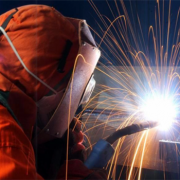Shielding gas for TIG welding
Shielding gas is one of the key parameters in the TIG welding process. We know that the shielding gas is mainly Ar and CO2 used in TIG welding, in many applications, O2, H₂, He or N₂ can be added to improve the welding quality. In addition to argon, helium or a mixture of argon and helium can be used as shielding gases for TIG welding. Today we will introduce the welding performances of this gas medium.
Helium (He)
He arc welding can weld almost any metal material.
1) He has a high ionization potential, which makes arc initiation difficult and has poor arc initiation performance during welding.
2) The thermal conductivity of helium is almost 8.8 times that of argon, so more heat is lost outward from the arc column. Under the same welding current and arc length conditions, the voltage of the helium arc is much higher than that of argon arc, so that the arc has greater power and more heat is transferred to the workpiece. At the same time, the helium gas has a good cooling effect, and the high energy density, the arc column is thin and concentrated, making the workpiece has a large depth of fusion.
3) The density of He is small, only 0.14 times that of air and 0.1 times that of argon. Therefore, the welding area needs to be effectively protected because its flow is much larger than that of argon.
4) Helium is more expensive than argon, less cousumption, and is mostly used in some special situations such as welding nuclear reactor cooling rods, thick aluminum alloy plate.
Mixed gas
On the basis of single-component gas, adding a small amount of some gas in a certain proportion can change the shape and energy of the arc, improve the forming and mechanical properties of the weld, increase the welding efficiency and reduce the spatter. Mixtures commonly used today include:
1) Ar + He
The ratio of these inert gases is Ar+ (50%-70%) He. It is characterized by stable arc combustion, higher arc temperature, more heat obtained by welding parts, and penetration depth, almost twice that of argon arc welding.
2) Ar + H₂
Generally, about 5% H₂ is added. Hydrogen has great thermal conductivity and reducibility, which can increase arc temperature and enhance the input heat of the workpiece. CO pores in welds can be eliminated and inhibited when welding nickel and its alloys.
| Shielding gas | Volume fraction | Arc voltage | Chemical characteristics | Welding material |
| Ar | 99.99% | Low | Inert gases | Nonferrous metals, Stainless steel superalloy |
| He | 99.99% | High | Inert gases | Nonferrous metals, stainless steel superalloy |
| Ar+He | Ar+75%He | Medium | Inert gases | Al and its alloy, titanium and its alloy |
| Ar+H₂ | Ar+5%-15%H₂ | Medium | Reductive gas | Stainless steel , Nickel alloy |
,


